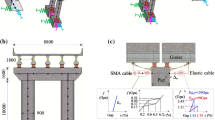Abstract
Steel restrainer cables for multiple-frame bridges in California in the United States showed the effectiveness to prevent the unseating at the internal hinges during the past several earthquakes. After that, the steel restrainer cables are being tried to apply for multiple-span-simply-supported (MSSS) bridges in the central and the southeastern regions in the United States. In addition, shape memory alloy (SMA) bars in tension are being studied for the same application. In multiple-frame bridges, the developed seismic forces are transferred to piers through the restrainers; however, in MSSS bridges, the seismic forces are transferred to abutments by the restrainers. Therefore, the abutment’s behavior should be investigated as well. This study assesses the seismic performance of the three types of restrainers—steel restrainer cables, SMA bars in tension, and SMA bars in bending for MSSS bridges—due to moderate to strong ground motions using a deterministic seismic analysis. Also, a fragility analysis is conduced to assess the seismic resistance for the overall bridge system. For these analyses, the bending test of an SMA bar is conducted and its analytical model is determined. Then, nonlinear time history analyses are conducted to assess the seismic responses of the as-built and the retrofitted bridges. The deterministic analysis illustrates how the restrainers influence the components of the bridge. However, it could not explain the effects on the whole bridge system. The fragility analysis shows the effects of the three restrainers on the overall bridge system. The fragility analysis indicates that the SMA bars in bending are the most effective ones.
Similar content being viewed by others
References
Copper, J.D., Friedland, I.M., Buckle, I.G., Nimis, R.B., Bob, N.M.: The Northridge Earthquake: progress made, lessons learned in seismic-resistant bridge design. Public Roads 58, 26–36 (1994)
CALTRANS: Bridge Design Specifications Manual. California Department of Transportation (1990)
DesRoches, R., Delemont, M.: Seismic retrofit of simply supported bridges using shape memory alloys. Eng. Struct. 24, 325–332 (2002)
Dolce, M., Cardone, D., Marnetto, R.: Implementation and testing of passive control devices based on shape memory alloys. Earthq. Eng. Struct. Dyn. 29, 945–968 (2000)
Wilde, K., Gardoni, P., Fukino, Y.: Base isolation system with shape memory alloy device for elevated highway bridges. Eng. Struct. 22, 222–229 (2000)
DesRoches, R., McCormick, J., Delemont, M.: Cyclic properties of superelastic shape memory alloy wires and bars. ASCE J. Struct. Eng. 130(1), 38–46 (2004)
Andrawes, R., DesRoches, R.: Unseating prevention for multiple frame bridges using superelastic devices. Smart Mater. Struct. 14, s60–s67 (2005)
Ocel, J., DesRoches, R., Leon, R.T., Hess, W.G., Krumme, R., Hayes, J.R., Sweeney, S.: Steel beam column connections using shape memory alloys. ASCE J. Struct. Eng. 130(5), 732–740 (2004)
Adachi, Y., Unjoh, S., Kondoh, M.: Development of a shape memory alloy damper for intelligent bridge systems. In: Proceedings of the International Symposium on Shape Memory Materials, Kanazawa, Japan, pp. 31–34 (1998)
Choi, E., Lee, D.H., Choei, N.-Y.: Shape memory alloy bending bars as seismic restrainers for bridges in seismic areas. Int. J. Steel Struct. 9(4), 261–273 (2009)
Duerig, T., Pelton, A., Stockel, D.: An overview of nitinol medical applications. Mater. Sci. Eng. A 273–275, 149–160 (1999)
Kaounides, L.: Advanced materials—Corporate strategies for competitive advantage in the 1990s. FT Management Reports, Pearson Professional Ltd., London (1995)
Tobushi, H., Hashimoto, T., Shimeno, Y., Takata, K.: Fatigue properties of TiNi shape memory alloy. Mater. Sci. Forum 327–328, 151–154 (2000)
Wagner, M., Sawaguchi, T., Kaustrater, G., Hoffken, D., Eggeler, G.: Structural fatigue of pseudoelastic NiTi shape memory wires. Mater. Sci. Eng. A 378, 105–109 (2004)
Miyazaki, S., Mizukoshi, K., Ueki, T., Sakuma, T., Liu, Y.: Fatigue life Ti-50 at.% Ni and Ti-40Ni-10Cu (at.%) shape memory alloy wires. Mater. Sci. Eng. A 273–275, 658–663 (1999)
Johnson, R., Padgett, J.E., Maragakis, M.E., DesRoches, R., Saiidi, S.: Large scale testing of nitinol shape memory alloy devices for retrofitting of bridges. Smart Mater. Struct. 17, 1–10 (2008)
Prakash, V., Powell, G.H., Campbell, S.D., Filippou, F.C.: DRAIN 2DX User Guide. Department of Civil Engineering, University of California at Berkeley (1992)
Mander, J.B., Kim, D.K., Chen, S.S., Premus, G.J.: Response of steel bridge bearings to the reversed cyclic loading. Technical Report NCEER 96-0014, Buffalo, NY (1996)
Choi, E., DesRoches, R., Nielson, B.: Seismic fragility of typical bridges in moderate seismic zones. Eng. Struct. 26, 187–199 (2004)
Maroney, B., Karl, R., Kutter, B.: Experimental testing of laterally loaded large scale bridge abutments. In: Structural Engineering in Natural Hazards Mitigation, pp. 1065–1070 (1993)
Tsai, N.C.: Spectrum-compatible motions for design purposes. ASCE J. Eng. Mech. Div. 98, 345–356 (1972)
Kaul, M.K.: Spectrum-consistent time-history generation. ASCE J. Eng. Mech. Div. 104, 781–788 (1978)
Lilhanand, K., Tseng, W.S.: Generation of synthetic time histories compatible with multiple damping design response spectra. In: SMiRT-9, Lausanne, Switzerland, K2/10, pp. 105–110 (1987)
Choi, D.H., Lee, S.H.: Multi-damping earthquake design spectra compatible motion histories. Nucl. Eng. Des. 226, 221–230 (2003)
AASHTO: AASHTO LRFD Bridge Design Specifications, SI Units 4th Edition. American Association of State Highway and Transportation Officials, Washington, DC (2007)
Wen, Y.K., Wu, C.L.: Uniform hazard ground motions for Mid-America cities. Earthq. Spectra 17(2), 359–384 (2001)
Dutta, A., Mander, J.B.: Seismic fragility analysis of highway bridges. In: Proceedings of the Center-to-Center Project Workshop on Earthquake Engineering in Transportation System, Tokyo, Japan (1999)
Dicleli, M.: Supplemental elastic stiffness to reduce isolator displacement for seismic-isolated bridges in near-fault zones. Eng. Struct. 29, 763–775 (2007)
Author information
Authors and Affiliations
Corresponding author
Rights and permissions
About this article
Cite this article
Choi, E., Park, J., Yoon, SJ. et al. Comparison of seismic performance of three restrainers for multiple-span bridges using fragility analysis. Nonlinear Dyn 61, 83–99 (2010). https://doi.org/10.1007/s11071-009-9633-6
Received:
Accepted:
Published:
Issue Date:
DOI: https://doi.org/10.1007/s11071-009-9633-6




